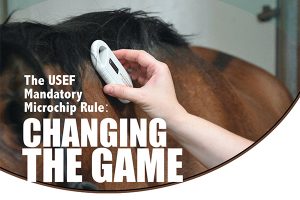Changing The Game – The USEF Mandatory Microchip Rule
Click here to read the complete article
108 – November/December, 2025
As of December 1, 2025, every horse entered in a USEF-licensed or -endorsed competition must be implanted with an ISO-compliant microchip. However, the new USEF Microchip Rule is more than just a requirement–it’s a game-changer for equestrian sports.
Designed to verify identity with certainty, this tiny chip also safeguards horse welfare, levels the playing field in competition and sales, and can even reunite lost horses with their owners.
Microchip Requirements of the USEF Rule
The new rule requires every microchip to follow ISO 11784/11785 standards, meaning each microchipped horse is assigned a unique 15-digit identification code. Microchips, about the size of a grain of rice, store electronic data linking to this identification code—providing a reliable way to confirm a horse’s identity.
Microchipping is a quick, routine veterinary procedure. The glass-encased microchip is implanted into the nuchal ligament on the left side of the horse’s neck, midway between the poll and withers. The vet preps the site and uses a sterile applicator to insert the chip. No sedation is typically needed, and the whole process takes only moments—much like a vaccination.
After a horse is microchipped, horse owners must report the 15-digit number to USEF. The easiest way is to log in to the My USEF Member Dashboard and update the horse’s record.
Click here to read the complete article
108 – November/December, 2025











